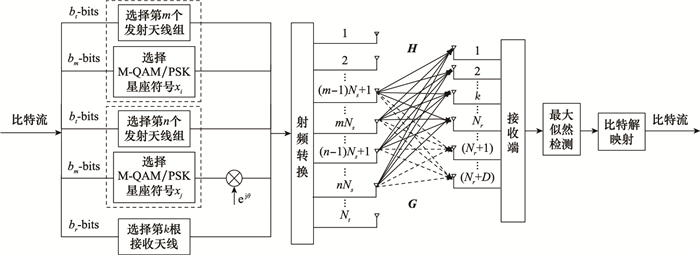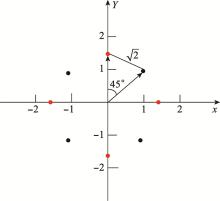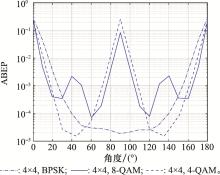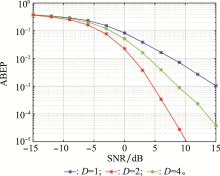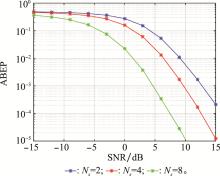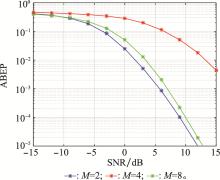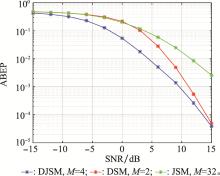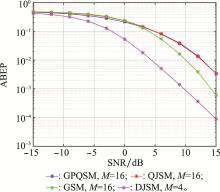Systems Engineering and Electronics ›› 2021, Vol. 43 ›› Issue (7): 1797-1803.doi: 10.12305/j.issn.1001-506X.2021.07.09
• Electronic Technology • Previous Articles Next Articles
Design and performance analysis of double joint transceiver spatial modulation scheme
Xiangyan BU1, Zhiquan BAI1,*, Ke PANG1, Xinhong HAO2, Piming MA1, Jian SUN1
- 1. School of Information Science and Engineering, Shandong University, Qingdao 266237, China
2. School of Mechatronical Engineering, Beijing Institute of Technology, Beijing 100081, China
-
Received:2020-09-09Online:2021-06-30Published:2021-07-08 -
Contact:Zhiquan BAI
CLC Number:
Cite this article
Xiangyan BU, Zhiquan BAI, Ke PANG, Xinhong HAO, Piming MA, Jian SUN. Design and performance analysis of double joint transceiver spatial modulation scheme[J]. Systems Engineering and Electronics, 2021, 43(7): 1797-1803.
share this article
| 1 |
MESLEH R Y , HAAS H , SINANOVIC S , et al. Spatial modulation[J]. IEEE Trans.on Vehicular Technology, 2008, 57 (4): 2228- 2242.
doi: 10.1109/TVT.2007.912136 |
| 2 |
RENZO M D , H AAS H , GRANT P M . Spatial modulation for multiple-antenna wireless systems: a survey[J]. IEEE Communi cations Magazine, 2011, 49 (12): 182- 191.
doi: 10.1109/MCOM.2011.6094024 |
| 3 | YANG P , DIRENZO M , XIAO Y , et al. Design guidelines for spatial modulation[J]. IEEE Communications Surveys & Tutorials, 2015, 17 (1): 6- 26. |
| 4 |
RENZO M D , HAAS H , GHRAYEB A , et al. Spatial modulation for generalized MIMO: challenges, opportunities, and implementation[J]. Proceedings of the IEEE, 2014, 102 (1): 56- 103.
doi: 10.1109/JPROC.2013.2287851 |
| 5 | 刘健伶, 陈志刚, 王磊. 一种自适应广义空间调制及其低复杂度算法[J]. 西安交通大学学报, 2016, 50 (4): 48- 53. |
| LIU J L , CHEN Z G , WANG L . An adaptive modulation algorithm with low complexity for generalized spatial modulation[J]. Journal of Xi'an Jiaotong University, 2016, 50 (4): 48- 53. | |
| 6 |
WANG J T , JIA S Y , SONG J . Generalised spatial modulation system with multiple active transmit antennas and low complexity detection scheme[J]. IEEE Trans.on Wireless Communications, 2012, 11 (4): 1605- 1615.
doi: 10.1109/TWC.2012.030512.111635 |
| 7 | 骆楷, 黄俊伟, 周朋光, 等. 正交空间调制的低复杂度检测算法[J]. 电信科学, 2017, 33 (5): 75- 81. |
| LUO K , HUANG J W , ZHOU P G , et al. A low-complexity detection algorithm for quadrature spatial modulation systems[J]. Telecommunications Science, 2017, 33 (5): 75- 81. | |
| 8 |
MESLEH R , IKKI S S , AGGOUNE H M . Quadrature spatial modulation[J]. IEEE Trans.on Vehicular Technology, 2015, 64 (6): 2738- 2742.
doi: 10.1109/TVT.2014.2344036 |
| 9 | YANG L L. Transmitter preprocessing aided spatial modulation for multiple-input multiple-output systems[C]//Proc. of the IEEE 73rd Vehicular Technology Conference, 2011. |
| 10 |
ZHANG R , YANG L L , HANZO L . Generalised pre-coding aided spatia l modulation[J]. IEEE Trans.on Wireless Communi- cations, 2013, 12 (11): 5434- 5443.
doi: 10.1109/TWC.2013.100213.130848 |
| 11 |
LUO J S , WANG S L , WANG F G , et al. Generalized precoding aided spatial modulation via receive antenna transition[J]. IEEE Wireless Communications Letters, 2019, 8 (3): 733- 736.
doi: 10.1109/LWC.2018.2889857 |
| 12 |
ZHANG R , YANG L L , HANZO L . Performance analysis of non-linear generalised pre-coding aided spatial modulation[J]. IEEE Trans.on Wireless Communications, 2016, 15 (10): 6731- 6741.
doi: 10.1109/TWC.2016.2588468 |
| 13 |
ZHANG R , YANG L L , HANZO L . Error probability and capacity analysis of generalised pre-coding aided spatial modulation[J]. IEEE Trans.on Wireless Communications, 2015, 14 (1): 364- 375.
doi: 10.1109/TWC.2014.2347297 |
| 14 |
SI Q T Y , JIN M L . A grouped pre-coding aided spatial modulation for MIMO systems[J]. IEEE Access, 2020, 8, 44643- 44651.
doi: 10.1109/ACCESS.2020.2978080 |
| 15 |
WEN P B , HE X , XIAO Y , et al. Efficient receive antenna selec -tion for pre-coding aided spatial modulation[J]. IEEE Communications Letters, 2018, 22 (2): 416- 419.
doi: 10.1109/LCOMM.2017.2732401 |
| 16 |
ZHENG J P . Fast receive antenna subset selection for precoding aided spatial modulation[J]. IEEE Wireless Communications Letters, 2015, 4 (3): 317- 320.
doi: 10.1109/LWC.2015.2413396 |
| 17 | 陈发堂, 杨康, 付永莉, 等. 预编码辅助广义正交空间调制的低复杂度检测[J]. 系统仿真学报, 2019, 31 (10): 2078- 2084. |
| CHEN F T , YANG K , FU Y L , et al. Low-complexity signal detection algorithm based on PGQSM[J]. Journal of System Simulation, 2019, 31 (10): 2078- 2084. | |
| 18 |
YANG P , XIAO Y , ZHANG B , et al. Star-QAM signaling constellations for spatial modulation[J]. IEEE Trans.on Vehicular Technology, 2014, 63 (8): 3741- 3749.
doi: 10.1109/TVT.2014.2306986 |
| 19 | VO B T, NGUYEN H H, TUAN H D. Constellation design for quadrature spatial modulation[C]//Proc. of the IEEE 86th Vehicular Technology Conference, 2017. |
| 20 | YIGIT Z, BASAR E. Double spatial modulation: a high-rate index modulation scheme for MIMO systems[C]//Proc. of the International Symposium on Wireless Communication Systems, 2016: 347-351. |
| 21 |
ALTHUNIBAT S , MESLEH R . Enhancing spatial modulation system performance through signal space diversity[J]. IEEE Communications Letters, 2018, 22 (6): 1136- 1139.
doi: 10.1109/LCOMM.2018.2817621 |
| 22 | YANG Y C, MA P M, PANG K, et al. Design of space signal diversity based quadrature spatial modulation[C]//Proc. of the 19th International Symposium on Communications and Information Technologies, 2019: 173-177. |
| 23 | MURTALA S , HOLOUBI T , MUCHENA N , et al. On the performance of the multiple active antenna spatial modulation with 3-dimensional constellation[J]. Applied Sciences-basel, 2020, 22 (6): 3718- 3726. |
| 24 |
CAO Y W , OHTSUKI T , JIANG X Q . Precoding aided generali zed spatial modulation with an iterative greedy algorithm[J]. IEEE Access, 2018, 6, 72449- 72457.
doi: 10.1109/ACCESS.2018.2880844 |
| 25 |
LIU C , YANG L L , WANG W , et al. Joint transmitter—receiver spatial modulation[J]. IEEE Access, 2018, 6, 6411- 6423.
doi: 10.1109/ACCESS.2018.2790959 |
| 26 |
LUO J S , WANG S L , WANG F G . Joint transmitter-receiver spatial modulation design via minimum euclidean distance maximization[J]. IEEE Journal on Selected Areas in Communications, 2019, 37 (9): 1986- 2000.
doi: 10.1109/JSAC.2019.2929380 |
| 27 | DONG R, WANG F G, LUO J S, et al. Quadrature joint transmitter-receiver spatial modulation[C]//Proc. of the 11th International Conference on Wireless Communications and Signal Processing, 2019. |
| 28 |
JEGANATHAN J , GHRAYEB A , SZCZECINSKI L . Spatial modulation: optimal detection and performance analysis[J]. IEEE Communications Letters, 2008, 12 (8): 545- 547.
doi: 10.1109/LCOMM.2008.080739 |
| 29 | GUO Y, WU W X, ZHU Z C, et al. Low complexity detection algorithm for generalized precoding aided spatial modulation[C]//Proc. of the IEEE/CIC International Conference on Communications, 2018: 163-166. |
| 30 |
MEN H Z , JIN M L . A low-complexity ML detection algorithm for spatial modulation systems with MPSK constellation[J]. IEEE Communications Letters, 2014, 18 (8): 1375- 1378.
doi: 10.1109/LCOMM.2014.2331283 |
| 31 |
YANG P , XIAO Y , ZHANG B , et al. Phase rotation-based precoding for spatial modulation systems[J]. IET Communications, 2015, 9 (10): 1315- 1323.
doi: 10.1049/iet-com.2014.1065 |
| 32 |
ZHENG J . Hybrid spatial modulation aided distributed relays: threshold detection and constellation rotation[J]. IEEE Access, 2017, 5, 21242- 21249.
doi: 10.1109/ACCESS.2017.2757512 |
| [1] | Yaohua XU, Chenglong ZHU, Yi WANG, Fang JANG, Mengqin DING, Huiping WANG. Neural network-based algorithm for high-parallelism massive MIMO signal detection [J]. Systems Engineering and Electronics, 2022, 44(12): 3843-3849. |
| [2] | Dan WANG, Jinzhi LIU, Zhiqiang MEI, Jiamin LIANG. Channel capacity optimization based on IRS-aided multi-user communication system [J]. Systems Engineering and Electronics, 2022, 44(12): 3871-3879. |
| [3] | Wei ZHANG, Xihong SANG, Hui HAN, Bowen YANG. Geometry based 3D V2V MIMO channel modeling and statistical characteristic analysis [J]. Systems Engineering and Electronics, 2022, 44(11): 3537-3547. |
| [4] | Huahua WANG, Yanshan LI, Zhihao ZHANG, Jiamin LIANG. Decentralized signal detection algorithm based on expectation propagation [J]. Systems Engineering and Electronics, 2022, 44(11): 3564-3570. |
| [5] | Yongquan JIANG, Hongcheng YIN, Chongjiang MO. Efficient calculation method of phase characteristics of defocusing feed in compact antenna test range [J]. Systems Engineering and Electronics, 2022, 44(10): 3046-3052. |
| [6] | He LI, wenjing ZHAO, Minglu JIN. Improved spectrum sensing algorithms based on high order moments of eigenvalues [J]. Systems Engineering and Electronics, 2022, 44(10): 3243-3248. |
| [7] | Yonglei QI, Xihong CHEN, Dizhe YUAN. Joint channel estimation and equalization algorithm based on UW for SC-FDE system [J]. Systems Engineering and Electronics, 2022, 44(10): 3258-3265. |
| [8] | Qian NIE, Lihua YANG, Bo HU, Lulu REN. Time-varying channel prediction method based on LSTM neural networks under basis expansion model [J]. Systems Engineering and Electronics, 2022, 44(9): 2971-2977. |
| [9] | Fang JIANG, Yaqing YANG, Guoliang ZHENG, Yi WANG, Yaohua XU, Xiangqing WU. Gradient pursuit multi-user detection algorithm based on time correlation [J]. Systems Engineering and Electronics, 2022, 44(9): 2955-2962. |
| [10] | Bo YANG, Yequn WANG, Guoce HUANG, Qilu SUN, Guisheng WANG. A trueful online double auction algorithm of the high frequency communication based on conflict decomposition [J]. Systems Engineering and Electronics, 2022, 44(9): 2947-2954. |
| [11] | Linghui LI, Wei LI, Jin JIN, Linling KUANG. Equivalent modeling method for interference analysis of 5G system to large-scale NGSO satellite system [J]. Systems Engineering and Electronics, 2022, 44(8): 2635-2644. |
| [12] | Zhenduo WANG, Yunfei ZHU, Xiaoyan NING, Ming DIAO. Combined ICI self-cancellation scheme for FrFT-OFDM system [J]. Systems Engineering and Electronics, 2022, 44(8): 2645-2651. |
| [13] | Lin SUN, Zhongyang MAO, Jiafang KANG, Lei ZHANG. Energy efficiency maximization-based spectrum allocation algorithm for maritime relay communication system [J]. Systems Engineering and Electronics, 2022, 44(8): 2661-2667. |
| [14] | Fatang CHEN, Jietang ZHANG, Pei HE, Junlin HUANG. Improvement of handover between different systems of mobile terminals [J]. Systems Engineering and Electronics, 2022, 44(8): 2668-2676. |
| [15] | Jiawei ZHANG, Fengchen QIAN, Junqiang YANG, Qian ZHAO, Zhengrong ZHANG. Survey on routing and spectrum allocation algorithm in elastic optical networks [J]. Systems Engineering and Electronics, 2022, 44(6): 2001-2010. |
| Viewed | ||||||
|
Full text |
|
|||||
|
Abstract |
|
|||||

